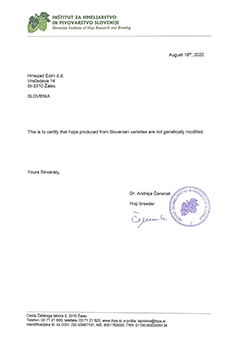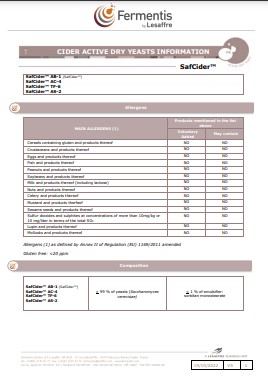Twój koszyk
Twój koszyk jest pusty
Aktualności firmowe
Nasze przyprawy
Nasze cukry
Nasze kapsle
-

 Crown Caps 26 mm TFS-PVC Free, Black col. 2217 Beer Season (10000/box)*
Dodaj do koszyka
Crown Caps 26 mm TFS-PVC Free, Black col. 2217 Beer Season (10000/box)*
Dodaj do koszyka
-
 Kapsle 26mm TFS-PVC Free, Cyan Opaque col. 2616 (10000/box)
Dodaj do koszyka
Kapsle 26mm TFS-PVC Free, Cyan Opaque col. 2616 (10000/box)
Dodaj do koszyka
-

 Crown Caps 29mm TP-PVC Free, Gold NEU col. 4310 (6500/box)
Dodaj do koszyka
Crown Caps 29mm TP-PVC Free, Gold NEU col. 4310 (6500/box)
Dodaj do koszyka
-
 Kegcaps 64 mm, Czerwony 56 Sankey S-type (EU) (1000/box)
Dodaj do koszyka
Kegcaps 64 mm, Czerwony 56 Sankey S-type (EU) (1000/box)
Dodaj do koszyka
-
 Kegcaps 74 mm, White 86 Flatfitting A-type (700/box)
Dodaj do koszyka
Kegcaps 74 mm, White 86 Flatfitting A-type (700/box)
Dodaj do koszyka
Słowniczek
General term for any actions taken to modify the characteristics of the brewing water. May involve filtration, reverse osmosis, distillation, and the addition of various minerals and/or acids.
Term applied to German wheat ales of the Bavarian, or Suddeutsch, style.
A German-style wheat ale, with a fruity/spicy character imparted by unique yeast strains. Unfiltered versions are generally referred to as Hefeweizen.
A Weizen (German-style wheat ale) which has been brewed to Bock strength (OG of at least 1.066).
A term used to describe the addition of freshly picked (not dehydrated) hops. Wet-hopped, or "harvest" beers are brewed by a select few breweries once a year, immediately following the hop harvest in early fall.
The second most common grain used in beer brewing. Malted wheat makes up at least 50% of the grist of traditional Weizen and Hefeweizen beers, and may also be added in lesser amounts in other styles (generally as an aid to head retention). Unmalted wheat makes up a substantial percentage of the grist in Witbier and Lambic.
These are tall, somewhat thin walled, sloped glasses with a solid base. They are typically 1/2 liter in capacity. They resemble a pilsner glass, only taller.
Wheat which has been malted (allowed to sprout, then dried). Wheat malt does not have the outer husk that is present on barley malt. Therefore, it must either be mashed with barley malt, and/or a lautering aid (e.g. rice hulls) must be added, to prevent a stuck sparge.
The practice of spinning the wort in a circular motion in the kettle, after the boil is complete. This causes the trub and spent hops to pile up in the center of the kettle, allowing relatively clear wort to be drawn off from the side.
Hops that have been dried and compressed but retain their natural form.
Any yeast other than the yeast that is intentionally introduced by the brewer. Some wild airborne yeasts can have drastic negative effects on the beer -- some will impart phenolic (or other) off flavors; others may "hyper attenuate" (i.e. ferment the beer down to a much lower FG than is desired).
Similar to a pub glass, but thinner walls and they stop angling out about 2/3 of the way up the glass and become straight at this point. Also called a becher.
A type of very pale malt dried in the sun or by exposure to the air, without kilning. Used in witbier.
"White" beer. The Belgian version of wheat beer brewed with coriander and curacao orange peel.
Belgian word for "white," a type of wheat beer brewed in the north, around Louvain. Often spiced with coriander and Curacao.
A pale, cloudy beer, brewed with a high percentage of unmalted wheat (and sometimes oats), and spiced with coriander and orange peel.
A device to rapidly cool wort. Usually copper tubing that has cold water running through it. Sometimes 2 tubes, one inside the other, with wort going through one and cold water going through the other. Also called a heat exchanger.












 Hmezad Hops, Genetically Free Certificate 2022
Hmezad Hops, Genetically Free Certificate 2022
 ChF Hops Non-Ionization and Non-Irradiation Certificate
ChF Hops Non-Ionization and Non-Irradiation Certificate
 Belgosuc Sugar, Certificate of conformity (EN)
Belgosuc Sugar, Certificate of conformity (EN)
 Crown Caps Finnkorkki Certificate of Conformity and Origin
Crown Caps Finnkorkki Certificate of Conformity and Origin
 Fermentis - Cider Dry Yeast Information 2023
Fermentis - Cider Dry Yeast Information 2023



